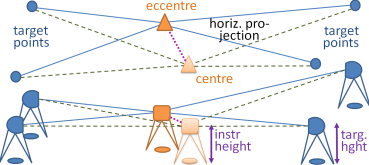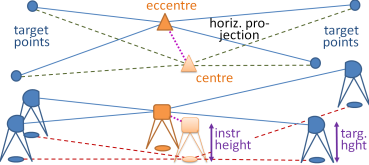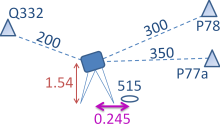
Due to setup or sighting obstacles it is oftentimes not possible to measure tacheometrically at the desired sites. In this case you can take measurements on the closest possible site and compute a station centring.
Naturally the centring computation slightly downgrades the accuracy of the measurements. This effect can be determined by a . However, this computation is only approximate for slope sightings, which is indicated by a warning.




For spatial centrings two options are available:
Vertical centring to
This selection is in effect only for spatial centring. If all instrument and target heights are zero, there is no difference here.
Angular measurements to remote target points Q332, P77a, P78 have been taken, however, not on the actual station point 551, but slightly offside, i.e. eccentrically. The distances to the targets are approximately known.
We try to generate measurements, as we would have taken them, if we would have measured on the actually desired station point 551 in the same instrument height. All target heights are zero, which is specified by the default value. In this case both options for Vertical centring are equivalent.

| Target | horizontal | zenith |
|---|---|---|
| Pname | angle | angle |
| Q332 | 0.0122 | 97.63886 |
| P77a | 177.5432 | 98.95436 |
| P78 | 191.2798 | 93.33680 |
We obtain the centric computation results displayed at the right. The standard deviations of the horizontal angles are enlarged for to 0.005…0.007 gon. By changing the input you find out that this effect is mainly due to the standard deviation of the horizontal angle from eccentre to centre being 5.0 gon . For the zenith angles no change is found.
|
|
|
|